Abstract
The development of a cell-mediated immune response to Sendai virus infection in mice was examined by the use of a 51Cr release assay of cytotoxicity. A low level of "background cytotoxicity" to Sendai virus-infected L cells was found in the spleens of uninfected CBA mice. Spleen cells from Sendai-infected mice showed an elevated level of cytotoxicity against these target cells for a period of 5 weeks, commencing 4 days after infection of the mice. A more transient response was observed in the spleens of mice infected with a serologically distinct virus, the Kunz strain of influenza. This cross-reacting, cell-mediated immune response was intermediate between that observed in unsensitized and Sendai-sensitized spleen cells. The relevance of these cell-mediated immune responses to respiratory tract virus infections is discussed.
Full text
PDF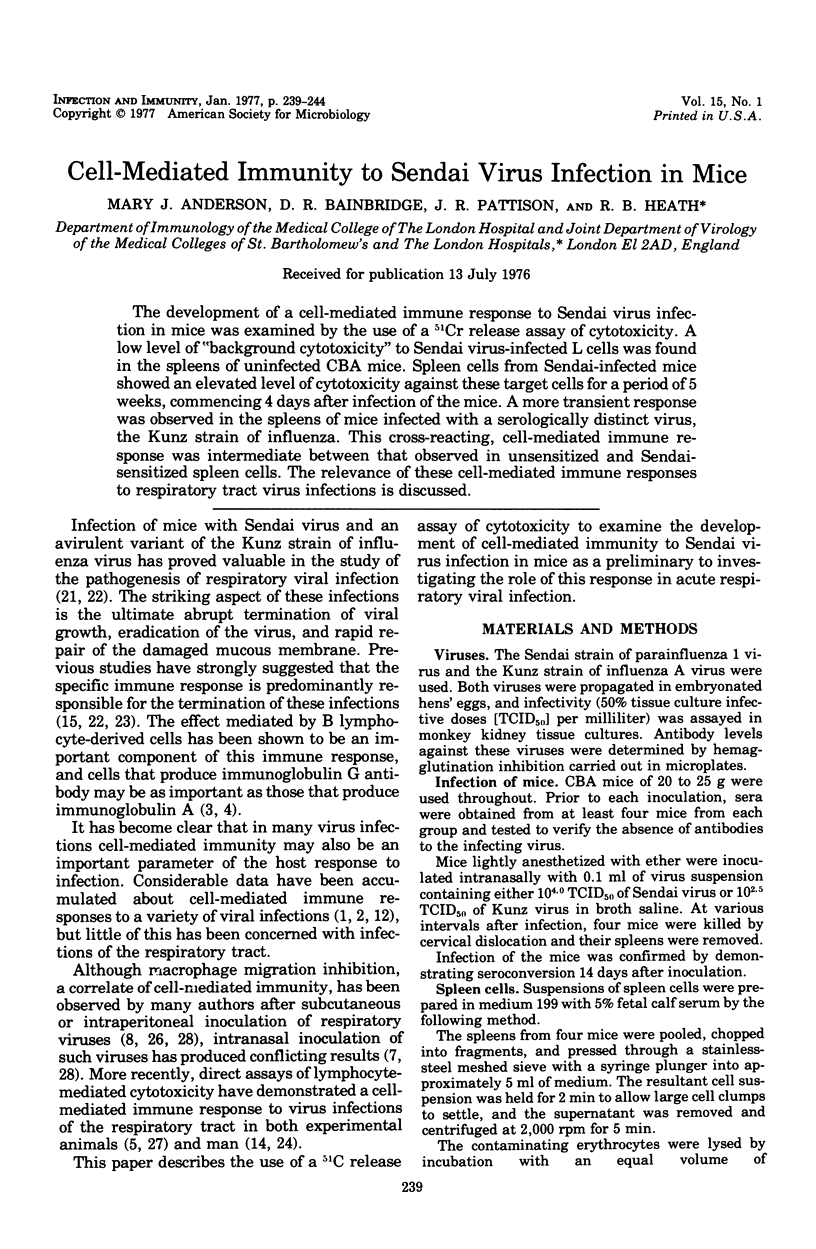
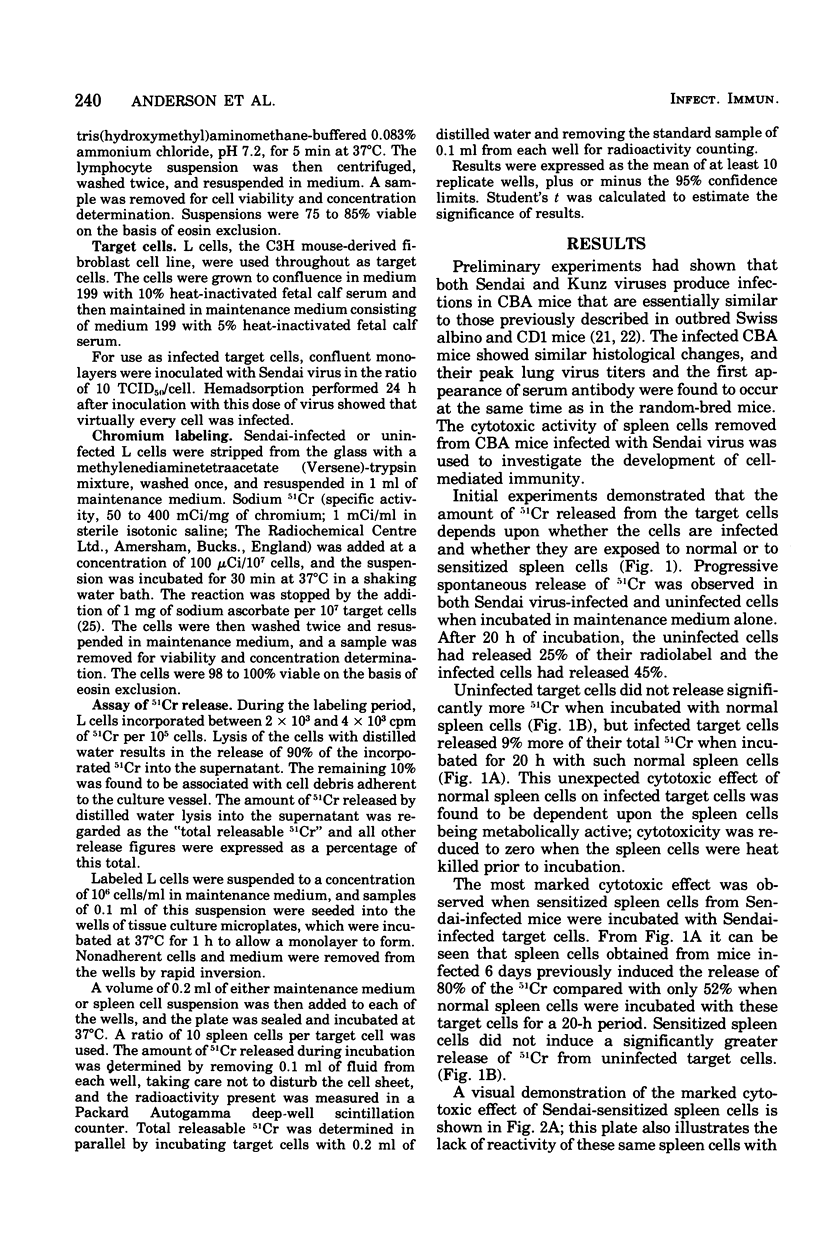
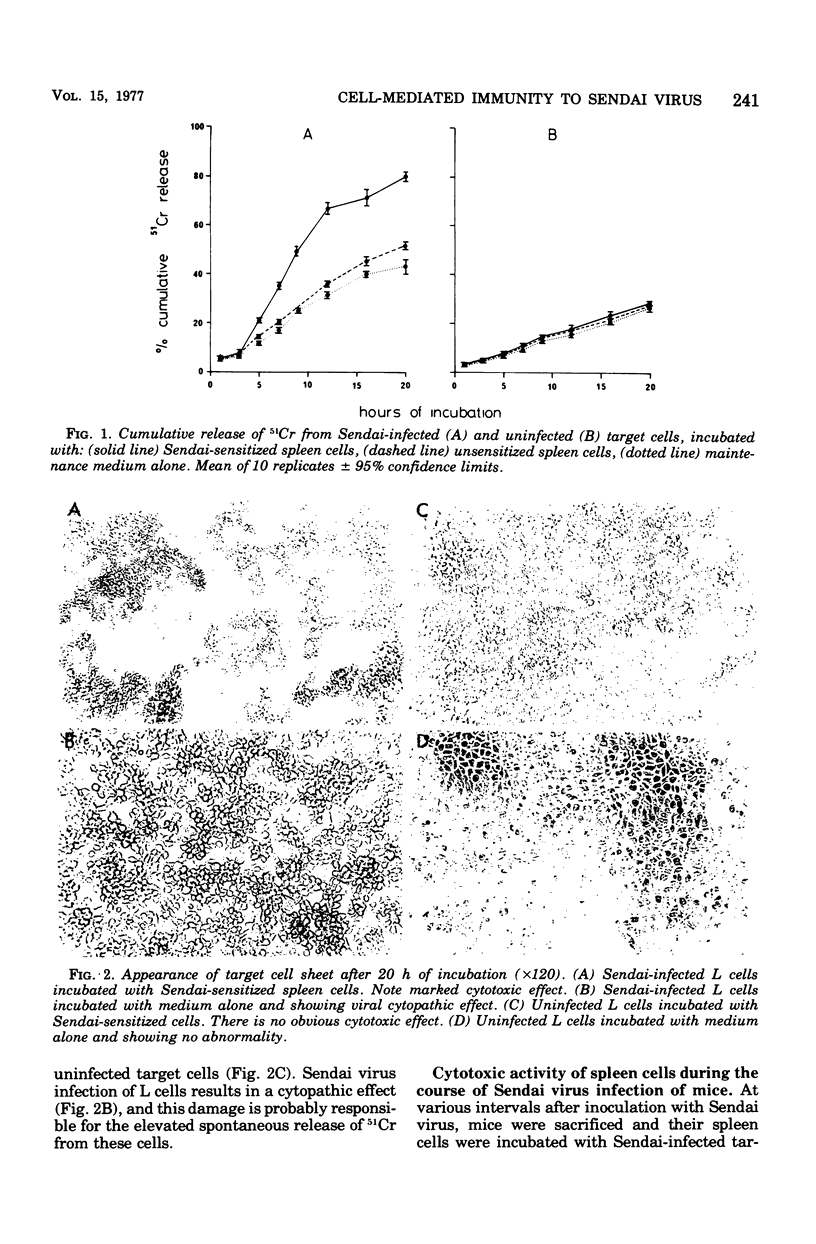
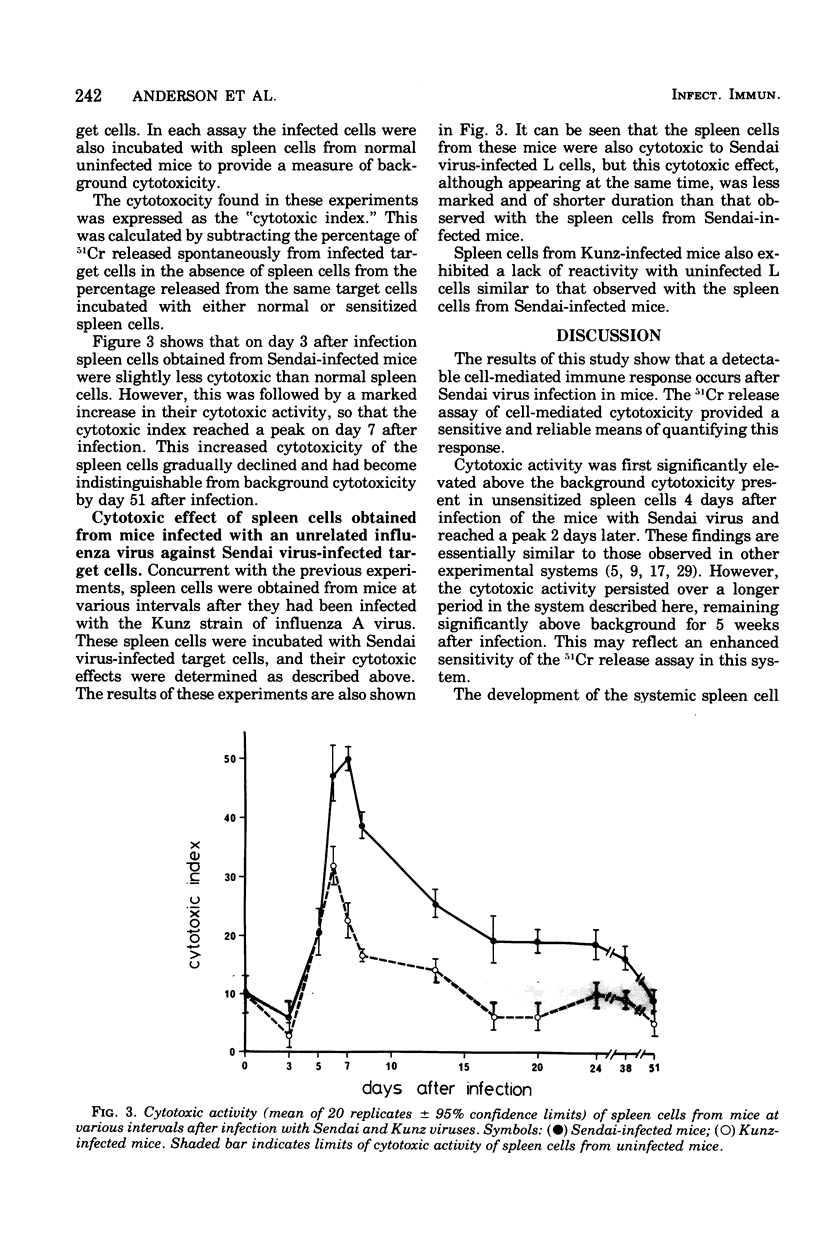
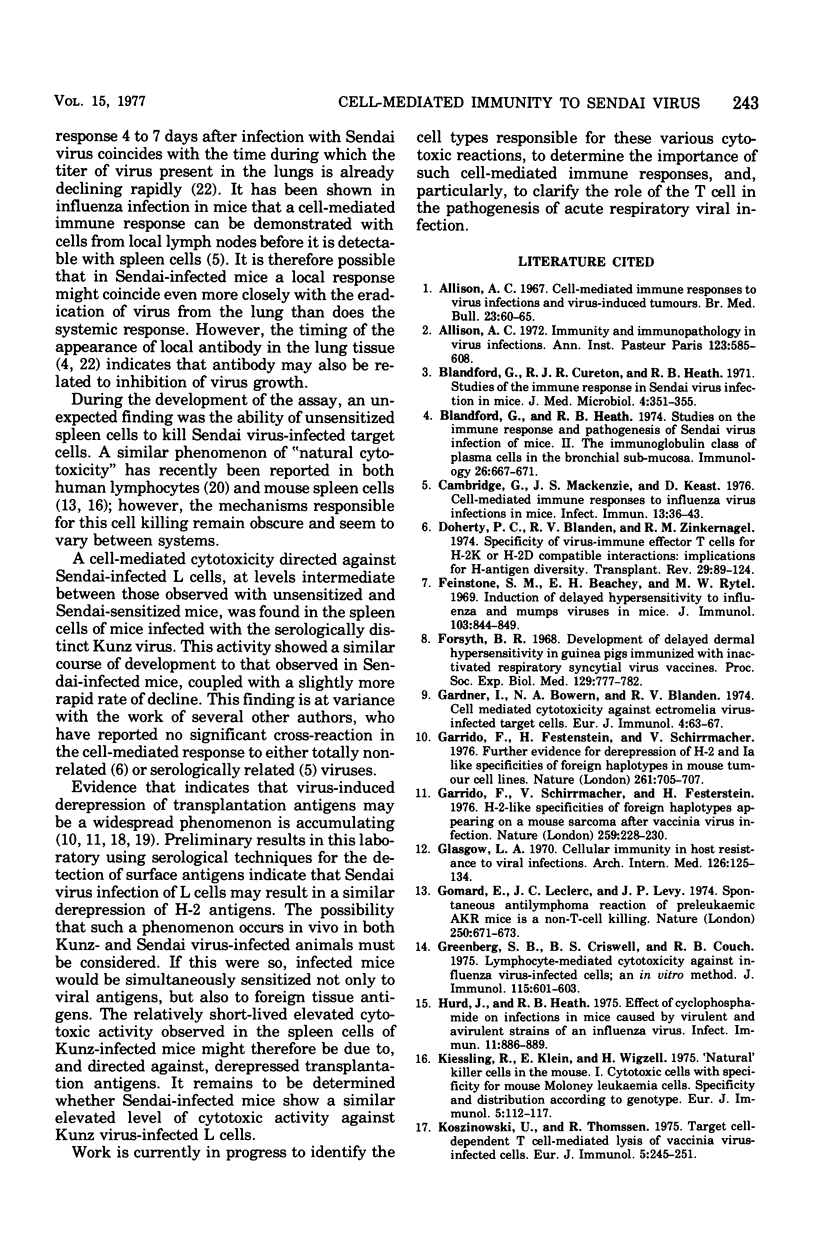
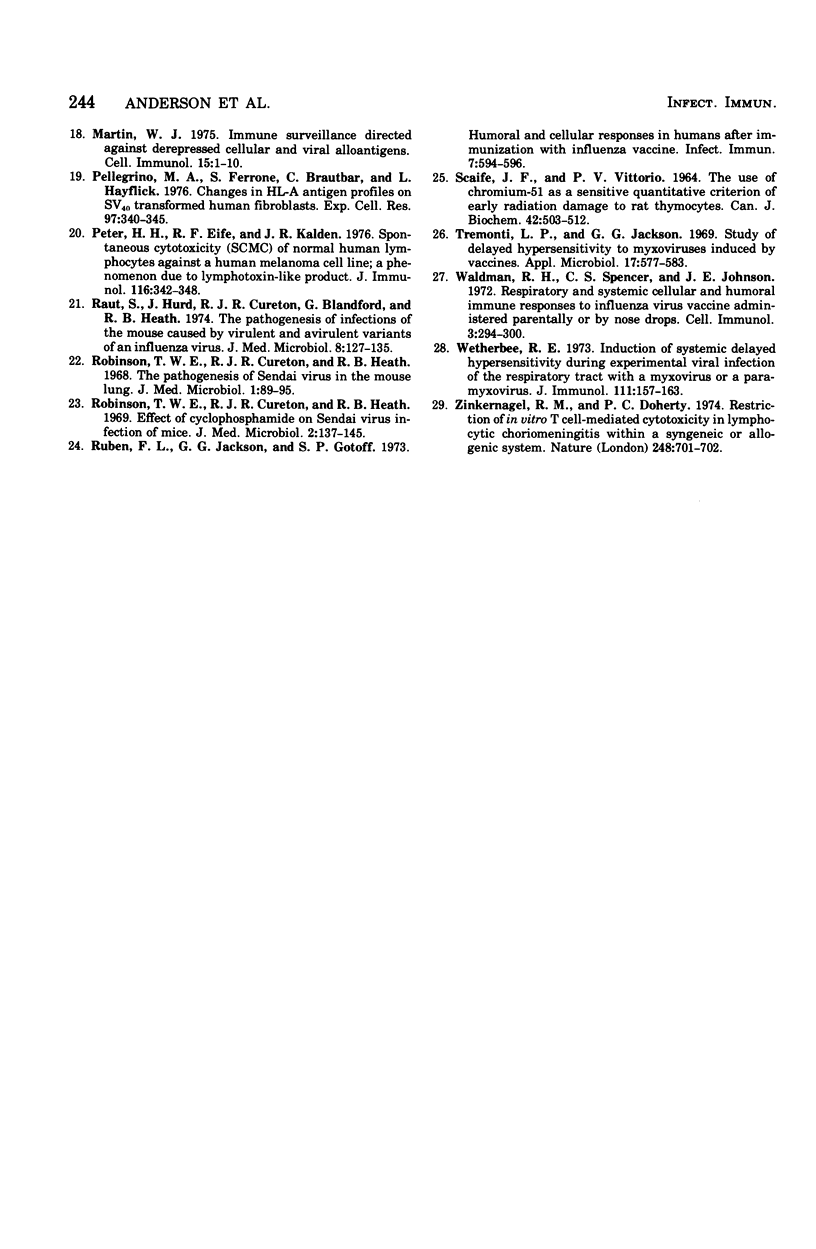
Images in this article
Selected References
These references are in PubMed. This may not be the complete list of references from this article.
- Allison A. C. Cell-mediated immune responses to virus infections and virus-induced tumours. Br Med Bull. 1967 Jan;23(1):60–65. doi: 10.1093/oxfordjournals.bmb.a070518. [DOI] [PubMed] [Google Scholar]
- Allison A. C. Immunity and immunopathology in virus infections. Ann Inst Pasteur (Paris) 1972 Oct;123(4):585–608. [PubMed] [Google Scholar]
- Blandford G., Cureton R. J., Heath R. B. Studies of the immune respnse in Sendai virus infection of mice. J Med Microbiol. 1971 Aug;4(3):351–356. doi: 10.1099/00222615-4-3-351. [DOI] [PubMed] [Google Scholar]
- Blandford G., Heath R. B. Studies on the immune response and pathogenesis of Sendai virus infection of mice. II. The immunoglobulin class of plasma cells in the bronchial sub-mucosa. Immunology. 1974 Mar;26(3):667–671. [PMC free article] [PubMed] [Google Scholar]
- Cambridge G., Mackenzie J. S., Keast D. Cell-mediated immune response to influenza virus infections in mice. Infect Immun. 1976 Jan;13(1):36–43. doi: 10.1128/iai.13.1.36-43.1976. [DOI] [PMC free article] [PubMed] [Google Scholar]
- Doherty P. C., Blanden R. V., Zinkernagel R. M. Specificity of virus-immune effector T cells for H-2K or H-2D compatible interactions: implications for H-antigen diversity. Transplant Rev. 1976;29:89–124. doi: 10.1111/j.1600-065x.1976.tb00198.x. [DOI] [PubMed] [Google Scholar]
- Feinstone S. M., Beachey E. H., Rytel M. W. Induction of delayed hypersensitivity to influenza and mumps viruses in mice. J Immunol. 1969 Oct;103(4):844–849. [PubMed] [Google Scholar]
- Forsyth B. R. Development of delayed dermal hypersensitivity in guinea pigs immunized with inactivated respiratory syncytial virus vaccines. Proc Soc Exp Biol Med. 1968 Dec;129(3):777–782. doi: 10.3181/00379727-129-33423. [DOI] [PubMed] [Google Scholar]
- Gardner I., Bowern N. A., Blanden R. V. Cell-mediated cytotoxicity against ectromelia virus-infected target cells. I. Specificity and kinetics. Eur J Immunol. 1974 Feb;4(2):63–67. doi: 10.1002/eji.1830040202. [DOI] [PubMed] [Google Scholar]
- Garrido F., Festenstein H., Schirrmacher V. Further evidence for depression of H-2 and Ia-like specificities of foreign haplotypes in mouse tumour cell lines. Nature. 1976 Jun 24;261(5562):705–707. doi: 10.1038/261705a0. [DOI] [PubMed] [Google Scholar]
- Garrido F., Schirrmacher V., Festenstein H. H-2-like specificities of foreign haplotypes appearing on a mouse sarcoma after vaccinia virus infection. Nature. 1976 Jan 22;259(5540):228–230. doi: 10.1038/259228a0. [DOI] [PubMed] [Google Scholar]
- Glasgow L. A. Cellular immunity in host resistance to viral infections. Arch Intern Med. 1970 Jul;126(1):125–134. [PubMed] [Google Scholar]
- Gomard E., Leclerc J. C., Levy J. P. Spontaneous antilymphoma reaction of preleukaemic AKR mice is a non-T-cell killing. Nature. 1974 Aug 23;250(5468):671–673. doi: 10.1038/250671a0. [DOI] [PubMed] [Google Scholar]
- Greenberg S. B., Criswell B. S., Couch R. B. Lymohocyte-mediated cytotoxicity against influenza virus-infected cells: an in vitro method. J Immunol. 1975 Aug;115(2):601–603. [PubMed] [Google Scholar]
- Hurd J., Heath R. B. Effect of cyclophosphamide on infections in mice caused by virulent and avirulent strains of influenza virus. Infect Immun. 1975 May;11(5):886–889. doi: 10.1128/iai.11.5.886-889.1975. [DOI] [PMC free article] [PubMed] [Google Scholar]
- Kiessling R., Klein E., Wigzell H. "Natural" killer cells in the mouse. I. Cytotoxic cells with specificity for mouse Moloney leukemia cells. Specificity and distribution according to genotype. Eur J Immunol. 1975 Feb;5(2):112–117. doi: 10.1002/eji.1830050208. [DOI] [PubMed] [Google Scholar]
- Koszinowski U., Thomssen R. Target cell-dependent T cell-mediated lysis of vaccinia virus-infected cells. Eur J Immunol. 1975 Apr;5(4):245–251. doi: 10.1002/eji.1830050405. [DOI] [PubMed] [Google Scholar]
- Martin W. J. Immune surveillance directed against depressed cellular and viral alloantigens. Cell Immunol. 1975 Jan;15(1):1–10. doi: 10.1016/0008-8749(75)90159-8. [DOI] [PubMed] [Google Scholar]
- Pellegrino M. A., Ferrone S., Brautbar C., Hayflick L. Changes in HL-A antigen profiles on SV40-transformed human fibroblasts. Exp Cell Res. 1976 Feb;97(2):340–345. doi: 10.1016/0014-4827(76)90625-x. [DOI] [PubMed] [Google Scholar]
- Peter H. H., Eife R. F., Kalden J. R. Spontaneous cytotoxicity (SCMC) of normal human lymphocytes against a human melanoma cell line: a phenomenon due to a lymphotoxin-like mediator. J Immunol. 1976 Feb;116(2):342–348. [PubMed] [Google Scholar]
- Raut S., Hurd J., Blandford G., Heath R. B., Cureton R. J. The pathogenesis of infections of the mouse caused by virulent and avirulent variants of an influenza virus. J Med Microbiol. 1975 Feb;8(1):127–136. doi: 10.1099/00222615-8-1-127. [DOI] [PubMed] [Google Scholar]
- Robinson T. W., Cureton R. J., Heath R. B. The effect of cyclophosphamide on Sendai virus infection of mice. J Med Microbiol. 1969 May;2(2):137–145. doi: 10.1099/00222615-2-2-137. [DOI] [PubMed] [Google Scholar]
- Robinson T. W., Cureton R. J., Heath R. B. The pathogenesis of Sendai virus infection in the mouse lung. J Med Microbiol. 1968 Aug;1(1):89–95. doi: 10.1099/00222615-1-1-89. [DOI] [PubMed] [Google Scholar]
- Ruben F. L., Jackson G. G., Gotoff S. P. Humoral and cellular response in humans after immunization with influenza vaccine. Infect Immun. 1973 Apr;7(4):594–596. doi: 10.1128/iai.7.4.594-596.1973. [DOI] [PMC free article] [PubMed] [Google Scholar]
- SCAIFE J. F., VITTORIO P. V. THE USE OF CHROMIUM-51 AS A SENSITIVE QUANTITATIVE CRITERION OF EARLY RADIATION DAMAGE TO RAT THYMOCYTES. Can J Biochem. 1964 Apr;42:503–512. doi: 10.1139/o64-059. [DOI] [PubMed] [Google Scholar]
- Tremonti L. P., Jackson G. G. Study of delayed hypersensitivity to myxoviruses induced by vaccines. Appl Microbiol. 1969 Apr;17(4):577–583. doi: 10.1128/am.17.4.577-583.1969. [DOI] [PMC free article] [PubMed] [Google Scholar]
- Waldman R. H., Spencer C. S., Johnson J. E., 3rd Respiratory and systemic cellular and humoral immune responses to influenza virus vaccine administered parenterally or by nose drops. Cell Immunol. 1972 Feb;3(2):294–300. doi: 10.1016/0008-8749(72)90168-2. [DOI] [PubMed] [Google Scholar]
- Wetherbee R. E. Induction of systemic delayed hypersensitivity during experimental viral infection of the respiratory tract with a myxovirus or paramyxovirus. J Immunol. 1973 Jul;111(1):157–163. [PubMed] [Google Scholar]
- Zinkernagel R. M., Doherty P. C. Restriction of in vitro T cell-mediated cytotoxicity in lymphocytic choriomeningitis within a syngeneic or semiallogeneic system. Nature. 1974 Apr 19;248(5450):701–702. doi: 10.1038/248701a0. [DOI] [PubMed] [Google Scholar]



